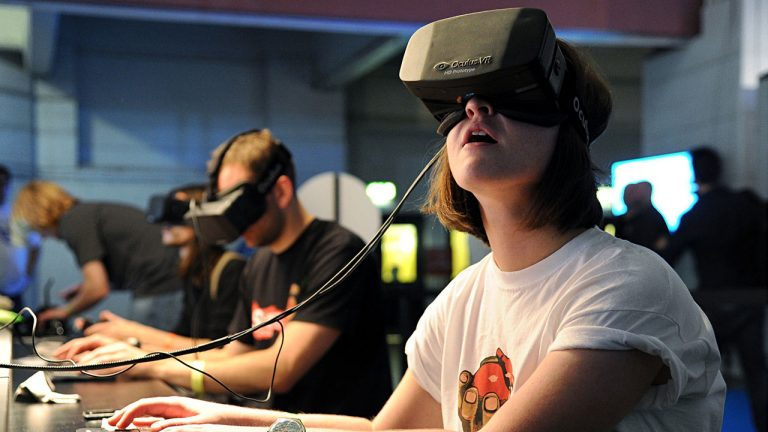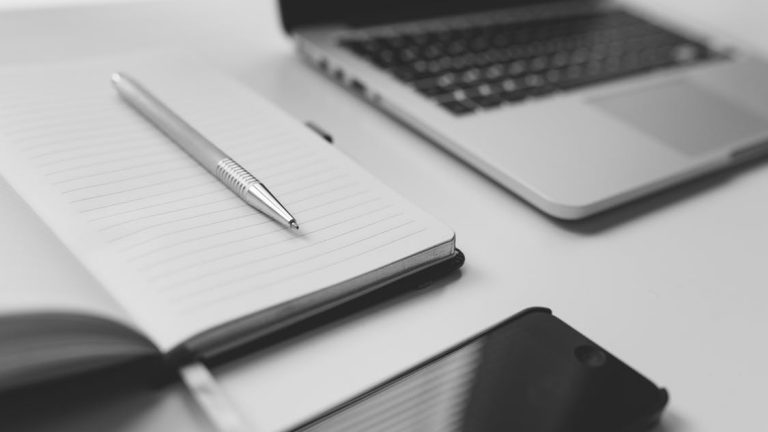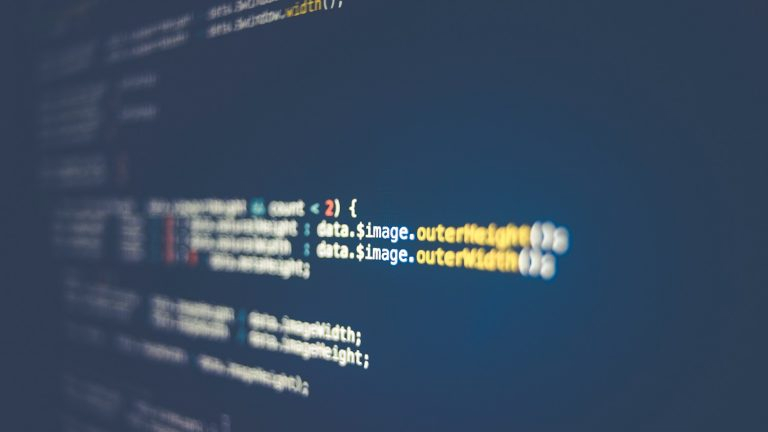Emerging technologies are making things exciting in every realm of life; things which were imagined only in fairy tales are becoming a reality today. Mobile made it possible to communicate with anyone we want to from anywhere and anytime, Virtual Reality is opening up possibilities to be anywhere we want to anytime we want to.
When the first commercial flight took off over a century ago, carrying 1200 passengers in a short span of 4 months, little did we know that the airline industry is going to change the way people travel forever. Back then, it was a mode of travel only for the elite; the first air ticket ever sold was purchased for $400 (a sum that would be equal to $10,000 today). Today, air travel has become accessible to most and carries a humungous 3.7 billion passengers per year. The airline industry has not just seen an avalanche of passengers but also an immense shift in the way it operates, thanks to the new and exciting technologies impacting the airline landscape.
The industry was firmly on cruise control when suddenly it crash landed in 2020. As the COVID-19 pandemic took over the world, one of the major industry to get hit severely was the aviation industry. The profits for airline carriers were at all time low and many private carriers shutting shop due to heavy losses. The total cumulative losses for aviation industry between the period of 2020-2022 is estimated to be $201 Bn.
But thanks to the ever-changing dynamics of the industry owing to the technological revolution and the ever-evolving nature of consumer behavior, the airline industry has managed to recover well from the unforeseen challenges and is on a trajectory to regain its earlier status. There are however still prevalent challenges pre-pandemic that have become major concerns for all airline organizations.
Some of the challenges that the airline industry has continuously been facing even in the pre-pandemic era are:
#1 Operational efficiency
#2 Declining workforce
#3 Increasing CX while maintaining operational costs
#4 Increasing fuel prices
#5 Maintaining quality service in wake of high customer demands
#6 Volatility in certain geo markets
In our article: How technology is giving flight to customer experiences in the airline industry, we detailed the way some challenges mentioned above impact the airline industry and how technology is helping them address these. We have also pitched for a new pricing model – Right Price Model, for airline business which tackles the important CX initiatives while maintaining operational costs.
Taking the discussion further, in this article we will look at the emerging technologies which are digitally transforming the airline industry and paving the way for the future of a digitally transformed and customer-centric airline industry.
1. Blockchain Technology
A blockchain is a distributed database that maintains a shared list of data or records.
Blockchain technology started out as one of the revolutionary solutions in financial sector. But the recent years have shown that this technology has many uses across multiple industries, including airlines.
The operation of the airline industry has a lot of moving parts and requires data sharing at multiple touchpoints from booking to arrival and even after that amongst multiple players including airlines, online travel portals, airports, immigration so on and so forth. Any leakage of the data through the entire cycle has the potential to not only diminish user experience and affect revenue but jeopardize passenger safety and security as well.
Benefits of blockchain technology in airline industry:
Identity Management & Record Keeping – Blockchain technology enables a hassle-free remote identity management system for airlines as compared to the laborious current biometric system. It can also help in safely keeping records of critical information such as passenger details, baggage onboarding, flight path, tracking down a lost entity, etc.
Cross Integrations for Seamless Travel Experience – Blockchain technology can help airlines turn the miles offered to the flyers into a more valuable asset that customers can use beyond the flying. It can integrate with other aspects of travel industry like ticketing, loyalty programs and non-airline logistical industries like transportation and hotels to create a unified seamless experience for travelers.
Building a robust data security system – With so many passenger records to maintain it is an uphill task for the airlines to manage and maintain the sanity and privacy of this data. Blockchain technology with a security wrapper can help in creating a unique and secure way of sharing and managing this information through the use of authorized access requirements.
Airline maintenance – Airlines have to deal with a humungous amount of data including cumbersome databases and sometimes manual binders when it comes to keeping a log of maintenance records. Blockchain can help the industry to ensure that these records are virtually recorded. Ensuring that all information regarding the procurement of the parts of the aircraft, the maintenance history, the person who has handled the maintenance, modifications that were done, etc. are recorded in real-time, virtually, and is accessible to relevant people when the records need to be accessed. All these details available at the right time without the chances of any error can improve the practice of maintenance, security, and safety to new levels.
Examples of blockchain technology uses in the airline industry:
– Air France deployed blockchain technologies to create a COVID-19 test verification system via a mobile app during the pandemic.
– British Airways and Zamna are working towards facial recognition features using blockchain.
– Etihad Airways partnered with Winding Tree for their blockchain travel platform.
– Singapore Airlines uses blockchain technology for their frequent flyer loyalty program using KrisPay. It also offers promotions to customers along with the program.
2. Augmented Reality and Virtual Reality
Industries like retail, healthcare, etc. are seeing a lot of uses of the AR/VR revolution. The airline industry is also following suit. Right now one of the most obvious applications of these technologies can be expected to be seen in the airport arena. AI can not only lessen the burden on human resource but increase satisfaction when used for customer service in airports.
Examples of AR/VR uses by some airports to delight their customers:
– The Gatwick airport uses AR to help passengers navigate the complex layout of the airport, and London City Airport has installed AR tech to help air traffic controllers with the vital job of keeping planes safe.
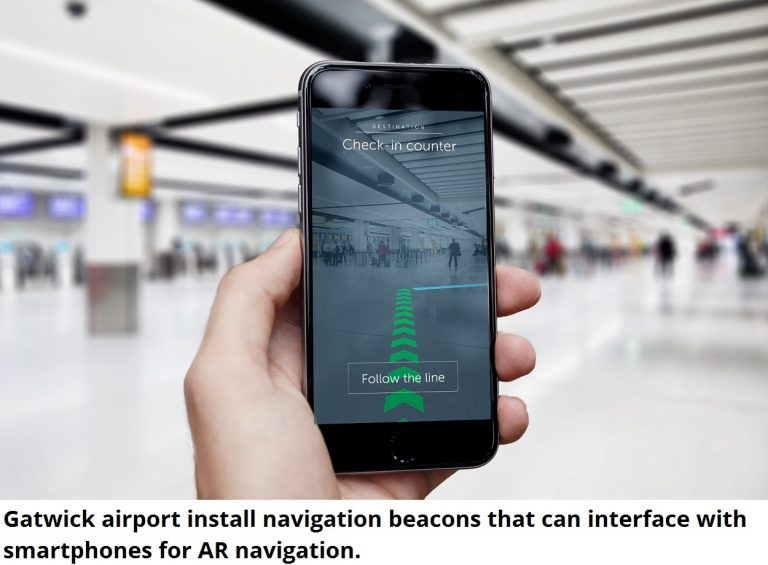
Image source: VRfocus.com
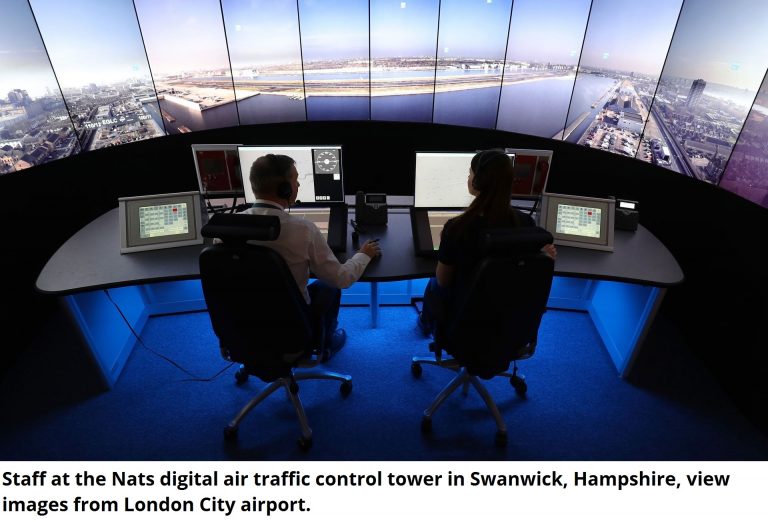 Image source: Guardian.com
Image source: Guardian.com
– Vodka brand Grey Goose created a multi-sensorial interactive AR experience at Heathrow Airport to engage with customers. As part of this experience, the customers can unveil three new flavors of the brand with simple hand gestures.
– Istanbul Airport created a virtual character called CiGA through AR technology that’ll accompany passengers around retail stores. The character presents special offers from participating retailers and directs them within iGA Istanbul Airport International Arrivals Bosphorus area.
– Another example of AR technology enhancing the airport experience is San Jose International Airport partnering with the Google Tango team for a trial of augmented reality technology in wayfinding, through airport retail promotions and even AR billboards displaying destination information.
According to Jonathan Vaden, lead of the project “Once augmented reality technology becomes ubiquitous, we will see many new and creative ways in which airports around the world begin taking advantage of its capabilities.’’
– Airlines are also starting to use AR/VR technology to create delightful customer experiences for their customers. Qantas is one such airline that has launched a VR app that provides its passengers with immersive, engaging, and experiential videos of the beautiful Australian destinations.
– Together, American and Microsoft are applying the power of AI, machine learning and data analytics to reduce the taxi time for flights, giving connecting customers extra time to make their next flight while also saving thousands of gallons of jet fuel and decreasing CO2 emissions for the American Airlines fleet. Built on Azure, American’s intelligent gating program provides real-time analysis of data points, including routing and runway information to automatically assign the nearest available gate to arriving aircraft.
3. Artificial Intelligence
AI is gaining traction in present times and becoming more and more equipped to understand human interactions. Many industries are using it to upgrade customer experience at every touchpoint. From chatbots to voice-based AI tools there are umpteen use cases of AI being utilized.
AI integrated with machine learning, and predictive analytics can help immensely in providing a connected and customized experience to the flyers. Further, AI also has the potential to ease out various operational processes of airlines like revenue management, managing ticket pricing, etc. A lot of forward-thinking airlines understand the impact AI can have in multiple areas of the industry and are already investing in the same.
Examples of AI technology uses in the airline industry:
– Shenzhen airport in China uses AI for AI airbridge allocation as well as for AI turnaround times. Another application of AI in airports can be found in autonomous airside operations.
– UK-based EasyJet uses AI predictive analysis to make sense of all the available customer data and use these insights to create offers and services personalized for individual travelers. The airline also has a recognition tool that reads passports and fills out all the information for flyers—easing the data entry and data management tasks more manageable.
– Air France implemented the specialized AI platform called Sky Breath that collects data from the flight, performs in-depth analytics, and helps identify fuel-saving opportunities and increase efficiency.
– Delta Airlines installed four self-service kiosks at the St. Paul International Airport that used facial recognition technology to verify customer identity by matching customer faces to their passport photos.
4. Beacons technology
Beacon technology has seen a lot of success when it comes to retail. Given the fact that GPS or Global Positioning System is dependent on the low ranging indoor satellite signals, there is a huge potential for the airline industry to use Beacons in making navigation easy for travelers between different terminals at the airport. Further, Beacons can help airports and vendors at the airport premises to know where passengers are and then send them personalized and relevant information accordingly. These updates can be about boarding gate number, baggage carousel, flight status, or also about the shops and eateries around the customer.
Examples of Beacons technology uses in the airline industry:
– MIAMI International airport is already leveraging Beacons on its premises to create a personalized experience for travelers. The app provides information about the entire airport as travelers navigate through various places on the premises. Further, they are also updated with relevant information depending on their individual journey, e.g. gate numbers, flight updates, baggage collection details, etc. Additionally, with the ‘blue-dot’ functionality, map rotation, turn-by-turn directions, ‘walk times’, and a ‘near me’ feature, they allow passengers to quickly locate virtually anything inside the airport.
– Central America’s one of the largest regional commercial operators, Aeromexico Connect, are trialing Beacon platform for key maintenance bases for a few months. The beacon will be assisting all maintenance operations and accelerate an aircraft’s return-to-service time. Further, it will integrate the platform into the airline’s stations to include their on-call maintenance providers as well.
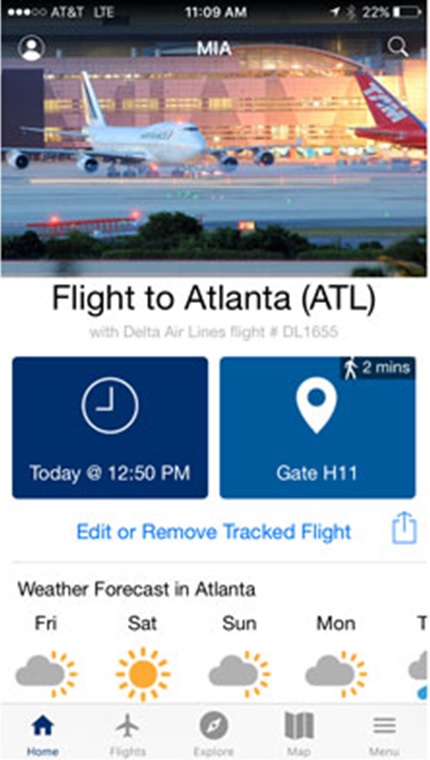
Image source: Internationalairportreview.com
5. Robotics
When we talk about use of robotics in aviation, we normally refer to manufacturing process of an airplane. As you know robotics help in various tasks during manufacturing such as drilling and fastening, welding, sealing and dispensing, inspection, rigid manufacturing, and transportation of parts.
However, the airline industry has also been using robotics in assisting various manual tasks at the airports. These include baggage handling, car parking, assisting with passenger check-in, temperature testing, or security, etc. Now, the implementation of robotics has gone beyond previous mentions as a customer-facing technology at airport terminals.
Examples of usage of robotics in aviation:
– The introduction of KLM’s socially aware ‘Spencer Robot’ in 2016 created a lot of buzz. This robot has been equipped with the capability to deal with social situations between people and can ‘see’ and analyze people nearby with his sensors. Spencer can also distinguish between individuals, families, and larger groups, and also learns about and then complies with social rules, ultimately acting in a human-friendly way.
– Airports like Glasgow Airport and airlines like Japan Airlines, EVA Air, etc. use robots as customer-service agents.
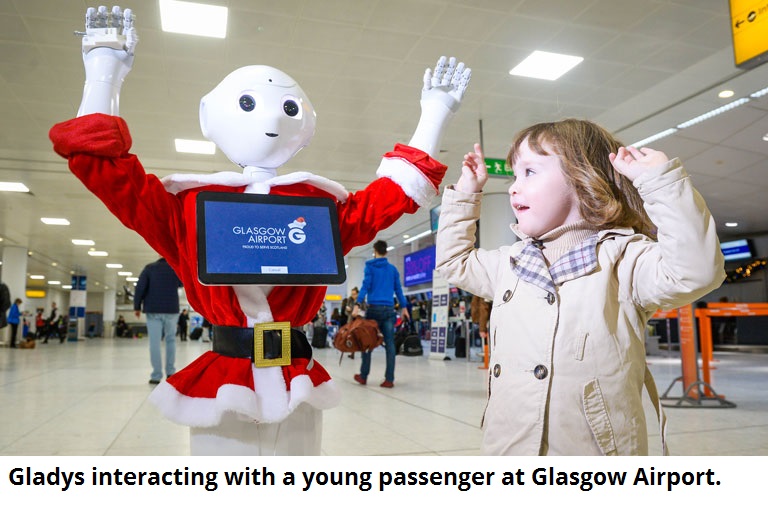
Image source: Futuretravelexperience.com
– Kansai Airport in Japan has deployed two security robots since 25 October 2021. These robots autonomously navigate and patrol routes, use a laser sensor to identify their locations and capture images with built-in cameras. They are programmed to stop and stand guard at their designated positions once their other tasks are finished.
– The robot named Pepper, launched by EVA Air, scans boarding passes to provide departure details, gives passengers weather updates for their destination, and informs them of duty-free special offers and airline promotions. Pepper can also play games, shake hands, dance, and pose for photos with travelers.
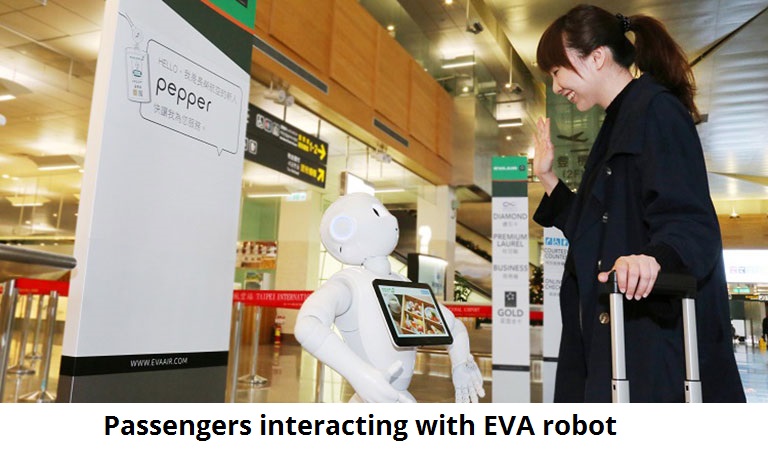
Image source – Futuretravelexperience.com
6. Biometrics
Biometrics is not new to aviation. All the major and minor airports started implementing it since 9/11 to improve their security details. But over the years it has found use in improving passenger experience as well by improving the time and speed of check-in and other operations.
Adopting Biometrics Technology at airlines and airport touchpoints is an attempt by the industry to add value to customers by delivering a delightful experience. For e.g. Delta Airlines launched the world’s first self-service biometric-enabled baggage drop to “free up more Delta people” to deal with customers.
The advantage of using biometrics at bag drop is two-fold: it helps in saving time for passengers and creating a visual record of the actual passenger dropping the bag – not just someone who might have picked up the suitcase owner’s boarding card.
Some examples of Biometric technology use in airports:
– Fraport in conjunction with Zwipe have agreed to trial their biometric solutions to boost security at Franfurt airport. The biometric data will not be stored in any centralized location which decreases the chance of a large security leak. Also, the use of contactless solutions decreases the chance of any spreading of germs or viruses in wake of the pandemic.
– Miami International Airport and US Customs and Border Protection (CBP) started rolling out biometric technology with a few airlines back in 2019. MIA is now seeking a huge biometric push by 2023 that will serve multiple purposes. Quoting Ralph Cutié, MIA Director and CEO here:
“We look forward to elevating our passenger experience with this state-of-the-art boarding solution. MIA is now the busiest U.S. airport for international travel and continues to set new records each month for passenger growth. Biometric boarding is one of the major steps we are taking to pave the way for additional growth in the years to come.”
Some of the critical locations where biometrics can be used are
- Check-in
- Bag-drop
- Security screening
- Duty free
- Airline lounge
- Border control
- Self-service boarding gate
- Destination immigration
Wearable technology
The wearable devices market was valued at $14.6 billion in 2019 and is expected to reach $85.6 billion by 2027, growing at a CAGR of 24.8%.
Initially designed to supplement the healthcare and fitness industry, wearables have found usage across other industries like retail, banking, and insurance to manufacturing and travel as well.
Airlines have started to use wearable technology in various ways to do more than improve customer experience on flights.
Some of the examples of airlines using wearable technology are:
– Hamad International Airport (HIA) has implemented the use of robotics and advanced thermal helmets in the post COVID-19 era as part of new measures being taken.
The Smart Screening Helmet is a wearable intelligent helmet, which is portable, safe and effective, and enables contactless temperature measurement.
– Japan Airlines use Microsoft’s HoloLens for training its new crew members and engineers. Using HoloLens, the mechanics can be trained in engine mechanics akin to the experience they will have working on an actual plane.
Microsoft has also demonstrated earlier that HoloLens can help in designing airport terminals by providing designers with imagery of the new terminals even before starting the construction.
– EasyJet and British Airways are among the airlines that have created apps for the Apple Watch, enabling passengers to store boarding passes and receive real-time updates on their wrists.
EasyJet has also introduced wearable uniforms for its crew and ground staff. The suit is fitted with hems and LEDs on the shoulders and can provide visual guidance to passengers. It is also equipped with built-in microphones to enable direct communication with passengers. Additionally, the uniform also has a LED-based scrolling ticker, on the lapel jacket, which displays basic information such as the number of the flight, the flight destinations, and lighting guidance in case of emergencies.
– Another, example of wearable devices being used to improve flight experience is the SkyZen app launched by The International Air Transport Association. The app is connected to the Jawbone fitness wristband and enables flyers to view their activity and sleep patterns throughout the flight and creates personalized insights based on their sleep and activity patterns.
8. Internet of Things
The objective of industries adopting IoT is to create a seamless and integrated ecosystem connecting organizational functions with the end consumers. The airline industry plunged into the IoT revolution with the same agenda – building a seamless and integrated ecosystem integrating the organizational functions to increase efficiencies and provide a seamless experience to their customers.
According to the FTE:
‘’Over the course of the next decade, it is likely that all “things” onboard will be connected and the health of everything, from engine performance to the IFE system, will be monitored in real-time. Sensors will automatically detect and report faults to maintenance teams on the ground, removing the need for the crew to manually report faults. Moreover, the addition of sensors to aircraft seats will enable the crew to monitor individual passenger health and wellbeing, and to proactively respond to their needs.’’
Examples of IoT in aviation industry:
– Virgin Airlines have implemented IoT in its Boeing 787. Every single element on the plane is attached to a wireless airplane network, providing real-time IoT data on elements like performance, maintenance, etc.
The airline is using the deluge of data that it is collecting through these flights to improve the efficiency of the aircraft and also be proactive. For example, a jet engine that is performing poorly mid-flight is relaying that information to ground staff throughout its journey, and when the plane lands, airport engineers can then be ready to look into the issue.
– Another example of the implementation of IoT by airlines is EasyJet’s Mobile Host at London’s Gatwick Airport. In this pilot, travelers’ flight details are combined with the live data from the airport’s Google indoor maps. This allows the airline to deliver updated check-in reminders, gate updates, and even personalized directions.
Though the implementation of a 360-degree implementation of IoT systems by airlines still has a long way to go, the process has definitely started on the right note.
9. Big Data
In a digitally connected universe, consumers leave their digital footprints at every touchpoint. Airlines can drive valuable insights by analyzing this data to create delightful experiences for travelers. E.g. Airlines can use this data to understand customer preferences in real-time based on data of their purchase history, travel itineraries, etc., and provide them with customized offers.
Some examples of Big data usage in aviation industry:
– United Airlines uses a smart ‘’collect, detect, act’’ system to analyze around 150 variables in the customer profile including their previous purchases, preferences, etc., and provide tailor-made offers to them. United Airlines has seen a YoY revenue increase of 15% after the implementation of this system.
Further, this data can also help in increasing operational efficiencies through predictive analytics. Predictive analytics can pre-empt any delays that might happen due to the weather forecast and in turn, inform the airline staff about it to keep their customers updated. Further, during any flight, a huge amount of data is generated with regards to pilot reports, incident reports, control positions, warning reports, etc. This data can be used in improving flight efficiency and safety.
– Southwest Airlines has partnered with NASA to indicate potential safety issues. By using machine-learning algorithms, they have built an automated system capable of crunching vast data sets to warn about anomalies and prevent potential accidents.
10. Mobile solutions
Today, smartphones have become an integral part of people’s life. With people spending a huge amount of time interacting with their devices, it has become increasingly important for industries to connect with their customers through the mobile platform.
Airlines have started venturing into the world of mobile solutions and are using this platform to connect with their customers throughout the passenger journey starting from booking a flight to deplaning it.
Examples of mobile solutions implementation in aviation:
– Delta Airlines recently started providing their passengers virtual boarding passes 24 hours before their journey through their mobile app, easing out the check-in process for their passengers.
Airlines not just are using mobile apps to make the entire process of booking flights, check-ins, etc. easier for travelers, they are also using apps in innovative ways to provide awesome in-flight experiences to the customers.
In our article, we take a detailed look at how Airlines are using the mobile platform to create delightful customer experiences.
5 ways how technology solutions can transform your Airport Facility Management ready for any pandemic level contingency
#1 IoT connectivity across user touchpoints
IoT enables the integration of data, systems, IoT connected tools, and mobile devices to create a unified platform to operate on. It detects data patterns left behind by customers and then translate the data into actionable insights. The insights act as recommendations and help detect problems before they occur.
IoT can be applied across various touchpoints of passenger journey from parking and departure to arrival and baggage claim.
Airport restrooms are using IoT equipped flush and urinal valves, faucet alerts for leaks and clogs, water usage monitoring and vacancy indicator lights – all these aid combine together to provide a streamlined experience for travelers.
Other aspects of airport operations, like retail revenue, luggage tracking and efficient terminal navigation can all be enhanced by IoT software.
#2 Touchless facility offerings
The coronavirus pandemic has been one such unprecedented event which forever changed our perception towards cleanliness and hygiene. The multitude of passengers coming and going from airports make them a prime hub for bacteria and pathogen transmission. Hence, the impetus is on airports to provide a touchless service across the whole journey of any passenger. According to Airport Council International, 89% of airports plan to implement touchless check-in self-service initiatives by 2023.
Major airports have already implemented touchless equipment upgrades across their facilities for both passengers and their employees. These equipment laced with features like biometric facial recognition and thermal scanning operations are making the airways a much safer way to travel.
#3 Smart restrooms across the entire arena
Restroom experience play a major role than anticipated in customer satisfaction when it comes to airports. Restrooms also act as an ideal place to gather real time data around restroom cleanliness and overall experience. Feedback devices placed around restrooms can notify facility management regarding immediate action required and save untimely cleanliness issues.
Devices and apps like autonomous floor scrubbers, attendant communication apps and automatic mobile alerts for faulty equipment help in providing a cleaner restroom experience. Also, some smart restroom apps can direct crew members to specific gates and times to respond to a specific day’s air traffic.
#4 Intelligent platform for airport operations
Airports can combine cutting edge technologies like AI, beacons, and mobile devices to optimize and streamline passenger experience.
Beacon technology can be used to help deliver real-time results like work order statuses, team member locations, audit results and other operational data. AI combined with beacons can provide real-time proximity data to mobile apps and drive airport cleaning efficiency, automatically dispatching the nearest team member to support emergent work orders.
Adopting up to date innovations and big data creates opportunities for airports to elevate passenger experience while optimizing operational efficiency, cost savings and resource management.
#5 Centralized control center
The fast transmission of coronavirus across international borders through air passengers have showed the importance of having a centralized data point and information center. Airports now find a routinely collected information about arrivals, departures and passenger counts more important than ever.
Airports can build a centralized dashboard and control center to have a single data source collected in one place to help airport teams make informed, long term, less reactive decisions. It can also help in having ultra-efficient labor management, data driven metrics to determine the macro effects of facility services and integrated predictive analytics. Also, a centralized data center can assist in proactive trend identification like passenger forecasts and seasonal peak models. These in turn help build proactively predictive models in case of potential surge.
In conclusion:
The course of travel industry was changed when Wright Brothers introduced the world to the flying machine. Today a century later the airline industry has grown by leaps and bound. Digital technologies are changing the landscape of every industry and the digital revolution in the airline industry has just begun. In times to come the airline travel experiences are set to become more personalized, valuable and memorable for the flyers.
With billions of smartphone users across the world spending a humongous share of their day interacting with the device, every business is trying to get into the fertile land of mobile apps to engage with their customers. No wonder the number of apps in the app stores has skyrocketed to around 5 million. While every business big or small wants to get into the mobile platform, most aren’t sure of the investments they will have to make for a viable mobile app.
There are millions of apps out there in the app stores vying for users’ attention. The apps which do get downloaded are abandoned in an eye’s blink. Almost 77% of users never use an app again 72 hours after installing. Time spent on apps is also low with 34.1% of mobile app engagements lasting less than one minute.
In this scenario, how can app developers make sure that their apps are not just downloaded but are retained as well?
“Only the autodidacts are free.”
― Nassim Nicholas Taleb, Author of “Black Swan“
“nahi jnAnEna sadRushaM pavitraM iha vidyatE”
— Bhagavdgeetha
Software development is one of the professions where its practitioners need to constantly keep themselves up to date with the rapidly changing field. Robert C Martin (Uncle Bob) in his much acclaimed book “The Clean Coder” has this to say:
In 2008, when we decided to enter the ‘mobile-app development-as-a-service’ business, little did we realize the extent to which the industry would change in less than 10 years. At launch, the App Store had just about 550 applications and a majority was paid (with most ranging from $0.99 to $9.99). The novelty factor of apps and the App Store drove the thinking behind app concepts back then. So we had apps which let out funny sounds when you waved the phone, mimicked a glass of beer and so on. Enterprises saw the benefit of getting on to the platform with news, finance and soon, e-commerce leading the way. Over the years, businesses have embraced mobile apps largely as a necessity than a fad.
Next major version of Java programming language is scheduled for general availability on 21 September, 2017. It is Java 9 (Java SE 9 Platform, JDK 9). Though this new version does not have as paradigm changing features as Java 5 or Java 8, it has got many interesting additions to the language, which has been the venerable workhorse of software development.
If you ask every executive in America about their top priorities this year, chances are the wide majority of them would say: digital transformation. No different than in 2016 when half of all business leaders thought the same.
In India, out of the1574 Urban Cooperative Banks (UCB’s) around 38% do not have Core Banking Solution (CBS). Most of the UCB’s are offering electronic fund transfer services like NEFT and RTGS in tie up with sponsor commercial banks. For customers of most of the cooperative segment, ‘branch banking’ was the only banking channel to bank upon, till recently. And they are serving nearly 60 crore customers.
Both traditional banks and new fintech companies recognize that the ease of use of a digital product is paramount to client satisfaction. And as we all know – client satisfaction is key to overall customer engagement, sales, long term banking-client relationships and growth.
But do banking executives understand just how important an exceptional user experience is for consumers?
The short answer is no.
